Categories
Archives
The IPTC is excited to announce that the IPTC Autumn Meeting 2024 is fast approaching, taking place from Monday September 30 to Wednesday October 2. This year’s event will be held virtually, providing IPTC members with the opportunity to stay informed and connected with industry leaders, no matter their location.
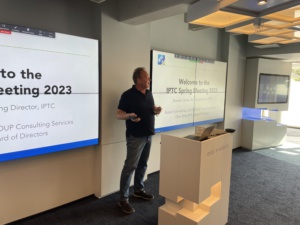
The Autumn Meeting will focus on the latest innovations in news metadata, standards, and tools that are shaping the future of digital content and journalism.
One of the key highlights of the meeting will be presentations by IPTC’s various Working Groups. These sessions will dive deep into advancements in metadata standards, addressing challenges like improving interoperability and adapting to the rapid rise of artificial intelligence in media.
Another focal point of the event will be updates on how new and existing IPTC standards like NewsML-G2, ninjs, Video Metadata Hub are helping news and media organisations to streamline the exchange of information. These tools play a critical role in ensuring that news content is delivered in a trusted and structured manner across platforms.
In addition to the technical presentations, the meeting will also feature case studies from IPTC member organizations. These will explore innovative uses of IPTC standards, such as the DPP Live Production Exchange project and the TEMS Trusted European Media Data Space.
The new IPTC Media Provenance Committee will come together to present to IPTC members recent activity in the working groups on Governance, Best Practices and Advocacy & Education around implementing media provenance technologies such as C2PA in newsrooms and media publishing workflows. We will hear from members such as CBC / Radio Canada on how these standards are helping media companies tackle issues like misinformation and content verification.
The event also includes the official IPTC Annual General Meeting (AGM), where Voting Members will participate in elections for the IPTC Board of Directors and vote on important decisions regarding the management of IPTC. The AGM is a great opportunity for members to shape the future direction of IPTC and its work on evolving industry standards.
The IPTC Standards Committee will meet to vote on proposed new standards from several working groups, including new versions of ninjs, NewsML-G2 and IPTC Sport Schema.
As always, registration for the IPTC Autumn Meeting is free for IPTC members. It’s an unmissable chance to engage with cutting-edge developments in the industry and collaborate with fellow professionals committed to improving news and media standards worldwide.
For more information and to register, visit IPTC Autumn Meeting 2024.
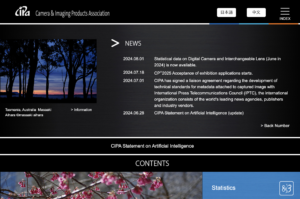
The IPTC has signed a liaison agreement with the Japanese camera-makers organisation and creators of the Exif metadata standard, CIPA.
CIPA members include all of the major camera manufacturers, including Nikon, Canon, Sony, Panasonic, FUJIFILM and more. Several software vendors who work with imaging are also members, including Adobe, Apple and Microsoft.
CIPA publishes guidelines and standards for camera manufacturers and imaging software developers. The most important of these from an IPTC point of view is the Exif standard for photographic metadata.
The IPTC and CIPA have had an informal relationship for many years, staying in touch regularly regarding developments in the world of image metadata. Given that the two organisations manage two of the most important standards for embedding metadata into image and video files, it’s important that we keep each other up to date.
Now the relationship has been formalised, meaning that the organisations can request to observe each other’s meetings, exchange members-only information when needed, and share information about forthcoming developments and industry requirements for new work in the field of media metadata and in related areas.
The news has also been announced by CIPA. According to the news post on CIPA’s website, “CIPA has signed a liaison agreement regarding the development of technical standards for metadata attached to captured image with International Press Telecommunications Council (IPTC), the international organization consists of the world’s leading news agencies, publishers and industry vendors.”
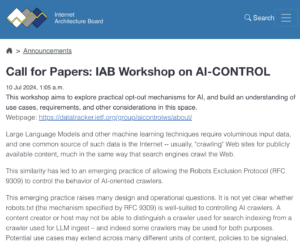
The Internet Architecture Board (IAB), a Committee of the Internet Engineering Task Force (IETF) which decides on standards and protocols that are used to govern the workings of Internet infrastructure, is having a workshop in September on “AI Control”. Discussions will include whether one or more new IETF standards should be defined to govern how AI systems work with Internet content.
As part of the lead-up to this workshop, the IAB and IETF have put out a call for position papers on AI opt-out techniques.
Accordingly, the IPTC Photo Metadata Working Group, in association with partner organisation the PLUS Coalition, submitted a position paper discussing in particular the Data Mining property which was added to the IPTC Photo Metadata Standard last year.
In the paper, the IPTC and PLUS set out their position that data mining opt-out information embedded in the metadata of media files is an essential part of any opt-out solution.
Here is a relevant section of the IPTC submission:
We respectfully suggest that Robots.txt alone is not a viable solution. Robots.txt may allow for communication of rights information applicable to all image assets on a website, or within a web directory, or on specific web pages. However, it is not an efficient method for communicating rights information for individual image files published to a web platform or website; as rights information typically varies from image to image, and as the publication of images to websites is increasingly dynamic.
In addition, the use of robots.txt requires that each user agent must be blocked separately, repeating all exclusions for each AI engine crawler robot. As a result, agents can only be blocked retrospectively — after they have already indexed a site once. This requires that publishers must constantly check their server logs, to search for new user agents crawling their data, and to identify and block bad actors.
In contrast, embedding rights declaration metadata directly into image and video files provides media-specific rights information, protecting images and video resources whether the site/page structure is preserved by crawlers — or the image files are scraped and separated from the original page/site. The owner, distributor, or publisher of an image can embed a coded signal into each image file, allowing downstream systems to read the embedded XMP metadata and to use that information to sort/categorise images and to comply with applicable permissions, prohibitions and constraints.
IPTC, PLUS and XMP metadata standards have been widely adopted and are broadly supported by software developers, as well as in use by major news media, search engines, and publishers for exchanging images in a workflow as part of an “operational best practice.” For example, Google Images currently uses a number of the existing IPTC and PLUS properties to signal ownership, licensor contact info and copyright. For details see https://iptc.org/standards/photo-metadata/quick-guide-to-iptc-photo-metadata-and-google-images/
The paper in PDF format can be downloaded from the IPTC site.
Thanks to David Riecks, Margaret Warren, Michael Steidl from the IPTC Photo Metadata Working Group and to Jeff Sedlik from PLUS for their work on the paper.
 The IPTC NewsCodes Working Group has released the latest update to IPTC NewsCodes vocabularies.
The IPTC NewsCodes Working Group has released the latest update to IPTC NewsCodes vocabularies.
The changes are quite minor this time, but we still recommend that users stay up to date with the latest version.
Changes to Media Topics vocabulary
Our main subject classification taxonomy, IPTC Media Topics, has seen the following updates:
1 new concept
- breaking (breakdance) (added earlier this year in time for the Paris 2024 Olympics)
1 retired concept
- missing in action (duplicate term added in error in the 2024 Q1 update. The existing term missing in action medtop:20000061 was moved to replace the newer term))
32 modified definitions
These changes mostly correct spelling errors in en-GB where US spellings had slipped in, such as changing “behavior” to “behaviour” for en-GB:
wireless technology, tobacco and nicotine, economic trends and indicators, international economic institution, stocks and securities, adult and continuing education, upper secondary education, social learning, medical condition, Confucianism, relations between religion and government, road cycling, competitive dancing, sexual misconduct, developmental disorder, fraternal and community group, cyber warfare, public transport, taxi and ride-hailing, shared transport, business reporting and performance, business restructuring, commercial real estate, residential real estate, podcast, financial service, business service, news industry, diversity, equity and inclusion, sustainability, profit sharing, breaking (breakdance).
As usual, the Media Topics vocabularies can be viewed in the following ways:
- In a collapsible tree view
- As a downloadable Excel spreadsheet
- On one page on the cv.iptc.org server
- In machine readable formats such as RDF/XML and Turtle using the SKOS vocabulary format: see the cv.iptc.org guidelines document for more detail.
Updates to other vocabularies
Horse Position (sphorposition)
New term “trainer” added to https://cv.iptc.org/newscodes/sphorposition. This term is needed by IPTC Sport Schema.
For more information on IPTC NewsCodes in general, please see the IPTC NewsCodes Guidelines.
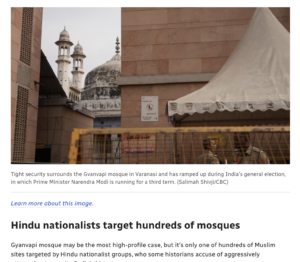
A few months in, things are going very well for the IPTC’s new Media Provenance Committee.
The IPTC Committee was initiated to continue the work started by Project Origin to bring the benefits of C2PA provenance technology to the news media industry. The Committee is chaired by Bruce MacCormack of CBC / Radio Canada.
The Committee has initiated three Working Groups who will be looking at specific issues:
- The Provenance Governance Working Group, led by Charlie Halford of the BBC.
- The Provenance Best Practices and Implementation Working Group, led by Helge O. Svela of Media City Bergen.
- The Provenance Advocacy and Education Working Group, led by Judy Parnall of the BBC.
We have also started the process of onboarding participants for the next phase of the Origin Verified News Publishers List, and have had several organisations already apply.
The first publishers on the list, BBC and CBC/Radio Canada, have already published some C2PA-signed content:
- The BBC has published some images and video with C2PA-embedded metadata showing the fact-checking process that has been undertaken by the BBC Verify fact-checking team.
- CBC / Radio Canada has published images signed with the CBC certificate on the cbc.ca website.
We are planning several events in the future to promote our work and encourage more in the media industry to get involved. Look out for news about IPTC Media Provenance work at the IBC Conference in Amsterdam in September and at other events.
If your organisation would like to be added to the list in the next phase or in the future, please get in touch!
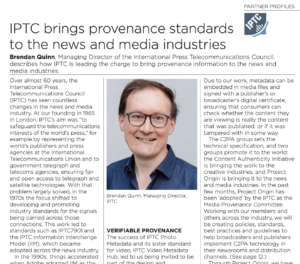
The IPTC’s Managing Director, Brendan Quinn, has written an article for the latest edition of the European Broadcasting Union’s technical magazine, EBU tech-i.
In the article, Brendan promotes the IPTC’s work in Media Provenance, including the founding of the IPTC Media Provenance Committee.
Brendan’s article can be found on page 17 of the PDF or print copy or the magazine.
The issue also contains a piece by Judy Parnall of the BBC, current Chair of the Committee, also covering C2PA and our joint work on media provenance.
The issue also contains interesting insights from European broadcasters on AI in media production, innovating to meet the challenges of covering the Paris 2024 Olympics, the creation of an Enterprise Architecture working group within the EBU membership, cybersecurity for media outlets, the future of broadcast radio in a world connected cars, and more.

Media consultant and IPTC Individual Member Denise Durand Kremer gave a presentation on IPTC Photo Metadata at the Seminário Fototeca Brasileira – the Brazilian Photo Library Seminar.
Over three days, more than 80 people got together to discuss the idea of a national photo library for Brazil. Denise was invited by the Collection and Market group Acervo e Mercado to talk about her experience as an iconographic researcher and about the IPTC standard for photographic metadata.
Photographers, teachers, researchers, archivists and public managers from institutions such as the Museu da Imagem e do Som de São Paulo – MIS (Museum of Image and Sound of São Paulo), Funarte, Instituto Moreira Salles, Zumví and Arquivo Afro Fotográfico participated in the event.
The meeting ended with a commitment from the Executive Secretary of the Ministry of Culture, to set up a working group to take the idea forward.
The seminar was recorded and will be available on SescTV.
Update, 6 August 2024: The video has now been released publicly. You can view Denise’s section below (in Brazilian Portuguese):
Thanks very much Denise for spreading the word about IPTC standards in Brazil!
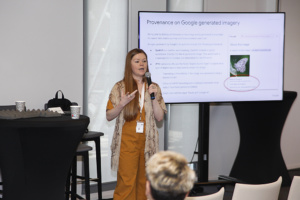
Last week CEPIC, the “centre of the picture industry”, held its annual Congress in Juan-les-Pins in France. This was the second time that the event was held at the Palais du Congres in Juan-les-Pins near Antibes, which is proving to be a great venue for the Congress with many repeat visitors who also attended last year.
IPTC was well represented at the event, with Managing Director Brendan Quinn presenting on two panels and many other IPTC members involved in presentations, panels or simply attending the event. IPTC members either presenting or in attendance included Google, Shutterstock, Getty Images, ANSA, IMATAG, PA Media / Alamy, TT, dpa, Adobe, Xinhua, Activo, APA, European Pressphoto Agency EPA and possibly more that we have missed!

One of the highlights for us was the Provenance and AI panel moderated by Anna Dickson, who until recently was with Google but is now with another IPTC member, Shutterstock. Presenters on this panel included Katharina Familia Almonte, product manager at Google, Andy Parsons, Director of the Content Authenticity Initiative (although Brendan ended up presenting his slides due to it being 4.30am for Andy in New York at the time!); Mathieu Desoubeaux, CEO of IPTC startup member IMATAG, and Brendan Quinn, Managing Director of IPTC.
Brendan used the opportunity to introduce the IPTC Media Provenance Committee and the work that the IPTC is doing on creating a C2PA Trust List for media organisations. Brendan put out a call for other media organisations who may be interested in joining the next cohort of certificate holders who will be able to obtain a certificate stored on the trust list and use it to cryptographically sign their media content. The discussion went on to look at the issues around using both C2PA and watermarking technology to protect image content.
Later in the day was the panel “Where Law and Technology Meet.” Moderated by Lars Modie (CEPIC, previously of IBL Bildbyrå / TT in Swededn) with speakers: Serguei Fomin (IQPlug, IPTC CEPIC representative), Brendan Quinn (IPTC), Franck Bardol (University of Geneva), Nancy Wolff (partner at the intellectual property, media and entertainment law firm of Cowan, DeBaets, Abrahams & Sheppard, LLP and DMLA counsel) and Katherine Briggs of Australian agency Envato which was recently acquired by Shutterstock.
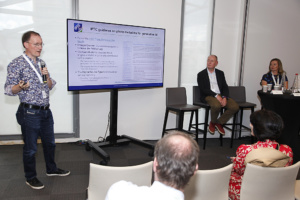
At this panel, Brendan outlined IPTC’s recent guidance on metadata for generative AI images. This includes the Digital Source Type property but also guidance on using the Creator, Contributor, and Data Mining properties to signal ownership and rights licensing information associated with images, particularly for engines that “scrape” web content to train generative AI models.
Many stimulating conversations always make the CEPIC Congress a valuable event for us to attend, and we are already looking forward to next year’s instalment.
Tuesday’s IPTC Photo Metadata Conference was a great success. With 12 speakers from the media and software industries and over 200 people registered, it continues to be the largest gathering of photo and image metadata experts globally.
Introduction and welcome, 20 years of IPTC Photo Metadata, Recent work on Photo Metadata at IPTC
We started off with David Riecks and Michael Steidl, co-leads of the IPTC Photo Metadata Working Group, giving an update on what the IPTC has been working on in the areas of photo metadata since the last conference in 2022, along with Brendan Quinn, IPTC Managing Director.
A lot has been happening, including Meta announcing support for IPTC metadata for Generative AI, launching the IPTC Media Provenance Committee and updating the IPTC Photo Metadata User Guide, including our guidance for how to tag Generative AI content with metadata and how to use the DigitalSourceType field.
Panel 1: AI and Image Authenticity
The first panel saw Leonard Rosenthol of Adobe, Lead of the C2PA Technical Working Group; Dennis Walker of Camera Bits, creators of Photo Mechanic; Dr. Neal Krawetz, Computer security specialist, forensic researcher, and founder of FotoForensics; and Bofu Chen, Founder & CTO of Numbers Protocol speak about image provenance and authenticity, covering the C2PA spec, the problems of fraudulent images, what it’s like to implement C2PA technology in existing software, and how blockchain-based systems could be built on top of C2PA to potentially extend its capabilities.
Session on Adobe’s Custom Metadata Panel
James Lockman, Group Manager, Digital Media Services at Adobe demonstrated the Custom Metadata Panel plugin for some Adobe tools (Bridge, Illustrator, Photoshop and Premiere Pro) that allows the full range of IPTC Photo Metadata Standard and IPTC Video Metadata Hub, or any other metadata schema, to be edited directly in Adobe’s interface.
Panel 2: AI-powered asset management
Speakers Nancy Wolff, Partner at Cowan, DeBaets, Abrahams & Sheppard, LLP; Serguei Fomine, Founder and CEO of IQPlug; Jeff Nova, Chief Executive Officer at Colorhythm and Mark Milstein, co-founder and Director of Business Development at vAIsual discussed the impact of AI on copyright, metadata and media asset management.
The full event recording is also available as a YouTube playlist.
Thanks to everyone for coming and especial thanks to our speakers. We’re already looking forward to next year!
The IPTC News Architecture Working Group is happy to announce the release of NewsML-G2 version 2.34.
This version, approved at the IPTC Standards Committee Meeting at the New York Times offices on Wednesday 17th April 2024, contains one small change and one additional feature:
Change Request 218, increase nesting of <related> tags: this allows for <related> items to contain child <related> items, up to three levels of nesting. This can be applied to many NewsML-G2 elements:
- pubHistory/published
- QualRelPropType (used in itemClass, action)
- schemeMeta
- ConceptRelationshipsGroup (used in concept, event, Flex1PropType, Flex1RolePropType, FlexPersonPropType, FlexOrganisationPropType, FlexGeoAreaPropType, FlexPOIPropType, FlexPartyPropType, FlexLocationPropType)
Note that we chose not to allow for recursive nesting because this caused problems with some XML code generators and XML editors.
Change Request 219, add dataMining element to rightsinfo: In accordance with other IPTC standards such as the IPTC Photo Metadata Standard and Video Metadata Hub, we have now added a new element to the <rightsInfo> block to convey a content owner’s wishes in terms of data mining of the content. We recommend the use of the PLUS Vocabulary that is also recommended for the other IPTC standards: https://ns.useplus.org/LDF/ldf-XMPSpecification#DataMining
Here are some examples of its use:
Denying all Generative AI / Machine Learning training using this content:
<rightsInfo> <dataMining uri="http://ns.useplus.org/ldf/vocab/DMI-PROHIBITED-AIMLTRAINING"/> </rightsInfo>
A simple text-based constraint:
<rightsInfo> <usageTerms> Data mining allowed for academic and research purposes only. </usageTerms> <dataMining uri="http://ns.useplus.org/ldf/vocab/DMI-PROHIBITED-SEECONSTRAINT" /> </rightsInfo>
A simple text based constraint, expressed using a QCode instead of a URI:
<rightsInfo> <usageTerms> Reprint rights excluded. </usageTerms> <dataMining qcode="plusvocab:DMI-PROHIBITED-SEECONSTRAINT" /> </rightsInfo>
A text-based constraint expressed in both English and French:
<rightsInfo> <usageTerms xml:lang="en"> Reprint rights excluded. </usageTerms> <usageTerms xml:lang="fr"> droits de réimpression exclus </usageTerms> <dataMining uri="http://ns.useplus.org/ldf/vocab/DMI-PROHIBITED-SEECONSTRAINT" /> </rightsInfo>
Using the “see embedded rights expression” constraint to express a complex machine-readable rights expression in RightsML:
<rightsInfo>
<rightsExpressionXML langid="http://www.w3.org/ns/odrl/2/">
<!-- RightsML goes here... -->
</rightsExpressionXML>
<dataMining uri="http://ns.useplus.org/ldf/vocab/DMI-PROHIBITED-SEEEMBEDDEDRIGHTSEXPR"/>>
</rightsInfo>
For more information, contact the IPTC News Architecture Working Group via the public NewsML-G2 mailing list.
Categories
Archives
- December 2025
- November 2025
- October 2025
- September 2025
- August 2025
- July 2025
- June 2025
- May 2025
- April 2025
- March 2025
- February 2025
- January 2025
- December 2024
- November 2024
- October 2024
- September 2024
- August 2024
- July 2024
- June 2024
- May 2024
- April 2024
- March 2024
- February 2024
- December 2023
- November 2023
- October 2023
- September 2023
- August 2023
- July 2023
- June 2023
- May 2023
- March 2023
- February 2023
- January 2023
- December 2022
- November 2022
- October 2022
- September 2022
- August 2022
- July 2022
- June 2022
- May 2022
- April 2022
- March 2022
- February 2022
- January 2022
- December 2021
- November 2021
- October 2021
- September 2021
- August 2021
- July 2021
- June 2021
- May 2021
- April 2021
- February 2021
- December 2020
- November 2020
- October 2020
- September 2020
- August 2020
- July 2020
- June 2020
- May 2020
- April 2020
- March 2020
- February 2020
- December 2019
- November 2019
- October 2019
- September 2019
- July 2019
- June 2019
- May 2019
- April 2019
- February 2019
- November 2018
- October 2018
- September 2018
- August 2018
- July 2018
- June 2018
- May 2018
- April 2018
- March 2018
- January 2018
- November 2017
- October 2017
- September 2017
- August 2017
- June 2017
- May 2017
- April 2017
- December 2016
- November 2016
- October 2016
- September 2016
- August 2016
- July 2016
- June 2016
- May 2016
- April 2016
- February 2016
- January 2016
- December 2015
- November 2015
- October 2015
- September 2015
- June 2015
- April 2015
- March 2015
- February 2015
- November 2014